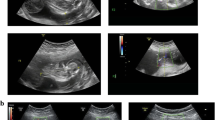Abstract
Objective
We aimed to evaluate perinatal outcome of seven pregnancies with twin reserve arterial perfusion sequence.
Materials and methods
Study group included seven cases of acardiac twins. Out of seven acardiac twins, two cases were followed without interventions. We performed four alcohol ablation and one bipolar caogulation. For alcohol ablation, a 20-gauge needle guided with color Doppler USG was directed to abdominal insertion site of the single umbilical artery of the acardiac twin, and 1.0–2.0 mL of absolute alcohol was injected. For bipolar coagulation of the umbilical cord, we used 3.5 mm laparoscopic trocar and 3.0 mm bipolar forceps. The procedures were performed under the guidance of transabdominal ultrasonography.
Results
Gestational age of the cases at diagnosis and at delivery was 15–32 and 17–38 weeks, respectively. Two cases without intervention were lost at 17 and 32 weeks. The mean time of procedure for bipolar coagulation and alcohol ablation were 30 and 10 min, respectively. One of the four cases of alcohol ablation group was aborted although alcohol ablation was succesful. Another one case was aborted after alcohol ablation due to lost of fetal cardiac activity of the pump fetus. In two other cases, umbilical cord ablation with alcohol was successful, and they delivered live birth at 36 and 38 weeks. In one case, we performed bipolar cord coagulation successfully, and the case delivered live birth at 39 weeks. The overall survival rate for intrauterine surgery was 60% (N 3/5).
Conclusion
In twin reserve arterial perfusion sequence pregnancies with findings of poor prognosis, alcohol ablation or bipolar cord coagulation as fetal therapy under the guidance of ultrasonography can be done successfully, and should be offered as a choice to families upon discussion of intervention or follow-up with own complications.
Similar content being viewed by others
References
James WH (1977) A note on the epidemiology of acardiac monsters. Teratology 16:211–216. doi:10.1002/tera.1420160216
Van Allen MI, Smith DW, Shepard TH (1983) Twin reversed arterial perfusion (TRAP) sequence: a study of 14 twin pregnancies with acardius. Semin Perinatol 7:285–293
Moore TR, Gale S, Benirschke K (1990) Perinatal outcome of forty-nine pregnancies complicated by acardiac twinning. Am J Obstet Gynecol 163:907–912
Sogaard K, Skibsted L, Brocks V (1999) Acardiac twins: pathophysiology, diagnosis, outcome, and treatment. Fetal Diagn Ther 14:53–59. doi:10.1159/000020889
Robie GF, Payne GG, Morgan MA (1989) Selective delivery of an acardiac, acephalic twin. N Engl J Med 320:512–513
Porreco RP, Barton SM, Haverkamp AD (1991) Occlusion of umbilical artery in acardiac, acephalic twin. Lancet 337:326–327. doi:10.1016/0140-6736(91)90946-M
Quintero RA, Reich H, Puder KS, Bardicef M, Evans MI, Cotton DB et al (1994) Brief report: Umbilical-cord ligation of an acardiac twin by fetoscopy at 19 weeks of gestation. N Engl J Med 330:469–471. doi:10.1056/NEJM199402173300705
Sepulveda W, Bower S, Hassan J, Fisk NM (1995) Ablation of acardiac twin by alcohol injection into the intra-abdominal umbilical artery. Obstet Gynecol 86:680–681. doi:10.1016/0029-7844(95)00171-M
Deprest JA, Audibert F, Van Schoubroeck D, Hecher K, Mahieu-Caputo D (2000) Bipolar coagulation of the umbilical cord in complicated monochorionic twin pregnancy. Am J Obstet Gynecol 182:340–345. doi:10.1016/S0002-9378(00)70221-3
Tsao K, Feldstein VA, Albanese CT, Sandberg PL, Lee H, Harrison MR et al (2002) Selective reduction of acardiac twin by radiofrequency ablation. Am J Obstet Gynecol 187:635–640. doi:10.1067/mob.2002.125242
Wong AE, Sepulveda W (2005) Acardiac anomaly: current issues in prenatal assessment and treatment. Prenat Diagn 25:796–806. doi:10.1002/pd.1269
Sullivan AE, Varner MW, Ball RH, Jackson M, Silver RM (2003) The management of acardiac twins: a conservative approach. Am J Obstet Gynecol 189:1310–1313. doi:10.1067/S0002-9378(03)00597-0
Brassard M, Fouron JC, Leduc L, Grignon A, Proulx F (1999) Prognostic markers in twin pregnancies with an acardiac fetus. Obstet Gynecol 94:409–414. doi:10.1016/S0029-7844(99)00404-4
Tan TY, Sepulveda W (2003) Acardiac twin: a systematic review of minimally invasive treatment modalities. Ultrasound Obstet Gynecol 22:409–419. doi:10.1002/uog.224
Sepulveda W, Corral E, Aiello H, Otano L, Paredes R, Escobar MF et al (2004) Intrafetal alcohol chemosclerosis of acardiac twins: a multicenter experience. Fetal Diagn Ther 19:448–452. doi:10.1159/000078998
Lewi L, Gratacos E, Ortibus E et al (2006) Pregnancy and infant outcome of 80 consecutive cord coagulations in complicated monochorionic multiple pregnancies. Am J Obstet Gynecol 194:782–789. doi:10.1016/j.ajog.2005.09.013
Porreco RP (2004) Percutaneous ultrasonographically guided ablation of an acardiac twin. Am J Obstet Gynecol 190:572–574. doi:10.1016/j.ajog.2003.07.001
Lee H, Wagner AJ, Sy E et al (2007) Efficacy of radiofrequency ablation for twin-reversed arterial perfusion sequence. Am J Obstet Gynecol 196:459.e1–4
Lewi L, Jani J, Deprest J (2005) Invasive antenatal interventions in complicated multiple pregnancies. Obstet Gynecol Clin North Am 32:105–126. doi:10.1016/j.ogc.2004.10.008
Deprest JA, Van Ballaear PP, Evrard VA, Peers KH, Spitz B, Steegers EA et al (1998) Experince with fetoscopic cord ligation. Eur J Obstet Gynecol Reprod Biol 81:157. doi:10.1016/S0301-2115(98)00181-X
Author information
Authors and Affiliations
Corresponding author
Rights and permissions
About this article
Cite this article
Gul, A., Gungorduk, K., Yildirim, G. et al. Fetal therapy in twin reserve arterial perfusion sequence pregnancies with alcohol ablation or bipolar cord coagulation. Arch Gynecol Obstet 279, 517–520 (2009). https://doi.org/10.1007/s00404-008-0746-9
Received:
Accepted:
Published:
Issue Date:
DOI: https://doi.org/10.1007/s00404-008-0746-9




